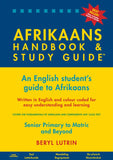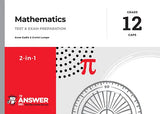
MATHS 4 AFRIKA GRADE 12
In Grade 12, learners are confronted with a lot of new work in addition to having to revise Grade 11 work before their exams. That is why it is important to keep up and to never, ever fall behind. Learners should make sure that they understand all new work being taught as they go along. In all of this, the Grade 12 Maths 4 Africa study guide is simply invaluable.
- In Grade 12, learners need to be able to work with different formulae for arithmetic and geometric sequences and series in addition to quadratic sequences as studied in Grade 11. Mixed sequences add an extra twist, and learners are also introduced to sigma notation. All of this is made simple in the Maths 4 Africa study guide, which offers exam-type questions in worked examples. The methods used are carefully explained using helpful tips, colour and highlighting.
- The concept of inverse functions, including switching between exponential and log functions (also graphically), could be quite daunting. However, this study guide focuses on explaining and illustrating everything in a simple manner aimed at enabling learners to understand the work and apply their knowledge and skills.
- In financial maths, two important new formulae are introduced. Learners are often confused by tricky time periods with regard to investments and loans. They sometimes feel that there seems to be a never-ending range of different scenarios and they never seem to know when to apply which rule. However, the Maths 4 Africa study guide makes quick work of explaining this section in a way which is easy to understand. Each type of problem is offered as a different scenario, and each scenario is worked through in the form of a worked example. All different types of scenarios are covered. In this way, learners can see exactly how one scenario differs from another and how they should deal with each.
- In the chapter on trigonometry, the different types of trigonometric equations that could be encountered are revised before moving on to compound and double angles. As in the rest of the book, the worked examples are invaluable as they also show learners how to tackle tricky types of questions.
- Many learners struggle with three-dimensional trigonometry – they find it difficult to differentiate between triangles in different planes. This chapter in the Maths 4 Africa study guide carefully explains how to go about such problems using colour, helpful tips and step-by-step explanations.
- When it comes to polynomials and differential calculus, this book is a real lifesaver. It shows learners exactly how to factorise cubic expressions in a quick and easy way and deals with the application of the remainder and factor theorem in a practical manner. The worked examples include exam-type questions, which learners will find very helpful. In the sections on limits, differentials (derivatives) and gradients, various important examples are included, all accompanied by helpful tips and using colour to emphasise important concepts. By doing so, the study guide helps learners understand exactly what to do in each case.
- With regard to cubic graphs, the Maths 4 Africa study guide highlights areas which learners often seem to struggle with and offers this information in a simple yet effective way, summarising important concepts along the way. Once again, various worked examples are provided to ensure that learners encounter and learn how to deal with all sorts of problems.
- Learners often find the link between a graph and the graphs of the original equation’s first and second derivatives quite difficult. This study guide takes time to show learners exactly how these are linked. Colour, concise notes and tips, simple sketches and worked examples based on exam-type questions are used to show the connections between these three types of graphs. The way this section (as well as the section on tangents to graphs) is explained in a manner which learners can easily understand is invaluable.
- Furthermore, learners often struggle with the application of differentiation in practical problems. The Maths 4 Africa study guide makes quick work of showing learners how simple it actually is to apply differentiation in various scenarios.
- In analytical geometry, learners are introduced to circle geometry, which is new to Grade 12. Important and tricky aspects are pointed out to learners and they are shown exactly how to approach these types of questions.
- When it comes to Euclidean geometry, many learners are quite lost. In Grade 12, learners work with proportionality and similarity in addition to applying the theorems studied in Grade 11. The Maths 4 Africa study guide carefully explains this work using various worked examples. Colour is cleverly used to help explain tricky concepts. Furthermore, sketches in worked examples are repeated in successive subquestions in order to show learners exactly what is being done in each new subquestion. This way, the writer was able to use colour extremely effectively to show learners the different steps of solving these problems. A large variety of worked examples are provided, giving learners the opportunity to really get the hang of this work.
- In the chapter on statistics, Grade 12 learners are introduced to the concepts of regression and correlation in a quick and easy manner. Using worked examples, learners are shown exactly how to use their calculators to find the standard deviation, the correlation coefficient and the equation of the regression line, and how to easily draw the regression line.
- The chapter on probability is absolutely great. In Grade 12, learners move on to applying the fundamental counting principle and using factorial notation. Learners sometimes find this section quite tricky, but the Maths 4 Africa study guide once again makes things easy. Colour, helpful tips and even clever little sketches are used to help learners understand and apply these new concepts.
- Furthermore, at the back of the study guide, learners are provided with the proofs of all new theorems they need to know for Grade 12, both for paper 1 and paper 2. (The rest of the proofs they need to know can be found at the back of the Grade 11 Maths 4 Africa study guide.) This means that they won’t have to run around in circles to find these proofs before exams, as these can simply be found at the back of the Grade 11 and 12 Maths 4 Africa study guides. As in all other chapters, colour and helpful tips are used to keep things simple and easily understandable by highlighting important steps.
- Learners who use the Grade 12 Maths 4 Africa study guide on a regular basis most certainly have an advantage over those who do not do so.
We Also Recommend





